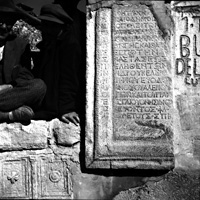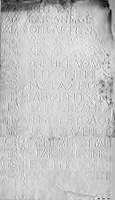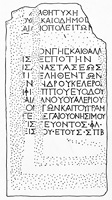 MAMA XI 91 (Traianopolis)
MAMA XI 91 (Traianopolis) 
Statue base for Septimius Severus
- Type of monument:
- Imperial statue base.
- Location:
- Ortaköy (Traianopolis): in a fountain on the main street.
- Description:
- Grey marble base, apparently complete; face of inscription damaged by modern channeling.
- Dimensions:
- Ht. 1.09; W. 0.56; Th. 0.52; letters 0.026-0.034.
- Record:
- Line drawing; MB notebook copy; squeeze; photographs (1955/113=1956/24).
- Publication:
- Buresch 1898: 169 (mentioned only); Körte 1902: 33-4, no. 60 [IGR IV 626].
- Date:
- AD 197/8 (Year 282 of Sullan era)
vac. ἀ̣[γ]αθῇ τύχῃ vac.
[ἡ β]ουλ̣ὴ̣ καὶ ὁ δῆμος [ὁ]
[Τρ]αια̣ν̣οπολειτῶν
〚[Αὐ]τ̣ο̣[κρ]ά̣τ̣[ορ]α̣ [Καί]σ̣α̣[ρα]〛
5〚[Λ(ούκιον) Σεπτίμιον Σεουῆ]〛-
〚[ρον]〛 [τ]ὸν γῆς καὶ θαλά-
[σσ]η̣ς δ̣εσπότην·
[τ]ῆ̣ς ἀ̣ναστάσεως
[ἐ]πιμ̣εληθέντων
10[Μ]ε̣ν[ά]νδρου Κέλερος̣
[κα]ὶ Φιλ̣ί̣ππου Εὐόδου
[κα]ὶ̣ Αἰλ̣[ι]ανοῦ Οὐαλερίου
[ἀρ]χ̣όν̣των καὶ τοῦ γραμ-
[μα]τέ[ω]ς Γαίου Ὀνησίμου,
15[λο]γ̣ιστ̣εύοντος · Φλ(αουΐου) ·
[Πρ]ε̣ίσ[κ]ου· ἔτους σπβ´.
Line 1: omitted by K(örte).
Lines 4-6: 〚Α[ὐ]τ[ο]κράτ[ορα Καίσαρα | Γ. Οὐίβιον Γάλλον | Σεβασ]〛τὸν γῆς K.
Lines 6-7: θαλά[σ]|σης K.
Line 10: Κελέρο[υ] K.
With good fortune. The council and the people of the Traianopolitai (set up this statue of) 〚Imperator Caesar L. Septimius Severus〛, the master of land and sea. The archontes Menandros Celer and Philippos Euodos and Aelianus Valerius and the grammateus Gaius Onesimos were responsible for the erection (of the statue). Fl. Priscus was logistes. Year 282.






This inscription was first copied by Karl Buresch in 1895. By the 1950s, the inscription had been badly defaced by modern channelling on the face of the monument; underlined letters in the text above were read by Buresch.
This monument is a statue base of an emperor who subsequently suffered damnatio memoriae at Traianopolis (lines 4-6). The inscription is dated to Year 282 (line 16). It is clear from two other dated inscriptions of Traianopolis that the Sullan era (85/4 BC) was in use at the city in the second century AD: the first, dating to Year 204 (=AD 119/20), is an honorific statue-base for the emperor Hadrian (Ramsay, Phrygia II 611-12, no. 515; IGR IV 623); the other, dating to Year 251 (=AD 167), is a statue-base for Marcus Aurelius and Lucius Verus (Ramsay, Phrygia II 612, no. 516; IGR IV 625; MAMA XI 90 (1956/30)).
If our inscription is dated by the Sullan era, the monument would date to AD 197/8, during the reign of Septimius Severus. However, Severus is not otherwise known to have suffered damnatio memoriae. Hence Körte assumed that at some point in the late second century AD the Traianopolitans shifted to using the Actian era, and therefore dated the inscription to AD 251/2, during the reign of Trebonianus Gallus, who did indeed suffer damnatio memoriae. However, this change of era is highly unlikely, and the fact that none of the individuals named in this inscription carry the gentilician Aurelius should suggest a date prior to the constitutio Antoniniana (Leschhorn 1993: 259-60). Most likely the inscription is to be dated to AD 197/8, and the name of Septimius Severus restored in lines 4-5 (thus already Buresch 1898: 169; W. Ruge, RE VI A 2, cols. 2085-6, s.v. Traianopolis). Why his name should have been erased on this monument is unknown.
The inscription is also dated by the tenure of office of the logistes Flavius Priscus (lines 15-16); on the office of the logistes in the Roman province of Asia, see Burton 1979; Dmitriev 2005: 189-97. If we are right to date this inscription to the Severan period, it is tempting to identify the logistes Flavius Priscus with T. Fl. Priscus the Younger (neoteros), a mint-magistrate at the neighbouring city of Akmoneia under Septimius Severus (BMC Phrygia 13-14, nos. 62-4; Campanile 1994: 98, no. 92); for an ancestor, T. Flavius Priscus Vibianus, see MAMA VI 266.